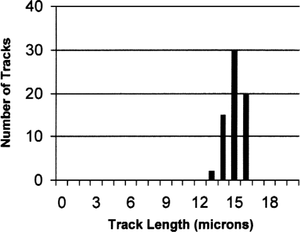Apatite fission track analysis
| Exploring for Oil and Gas Traps | |

| |
| Series | Treatise in Petroleum Geology |
|---|---|
| Part | Critical elements of the petroleum system |
| Chapter | Evaluating source rocks |
| Author | Carol A. Law |
| Link | Web page |
| Store | AAPG Store |
What is apatite fission track analysis?
Apatite fission tracks are formed when charged particles are released by the spontaneous nuclear fission of uranium 238 in apatite crystals. The highly charged particles released by the fission reaction damage the lattice of apatite crystals. The damage appears as linear features referred to as fission tracks.
The rate of decay of uranium 238 is a time-dependent reaction; therefore, the number of fission tracks in a crystal can be used to measure the time since the formation of the apatite grains. This is the basis for apatite fission track analysis.
Measuring maturity with apatite fission tracks
The continued existence of apatite fission tracks is temperature dependent. At temperatures below temperature::60°C the fission tracks exist as they were formed. However, as the temperature increases from 60-temperature::120°C, the length of the fission tracks in apatite crystals will decrease due to thermally induced “healing” of the crystal structure. This process is referred to as annealing.
The mean length of a fission track at the time of formation and up to temperature::60°C is 15μ. Fission tracks will completely anneal and disappear at approximately temperature::120°C. Therefore, the length of apatite fission tracks can be used as a measure of the maximum temperature that a rock has been subjected to and provides information related to thermal history.
Using analysis with ro
Apatite grains are commonly found in sandstones. The amount of information provided from fission track analysis can be significant and is very complementary to vitrinite data in portions of the geologic section that are lean in organic matter. See Duddy et al[1] and Gleadow et al[2] for a general overview of the interpretation and application of apatite fission track data in petroleum exploration.
Caveat
The chemistry of apatite is variable and can be significant enough to have an effect on the rate of fission track annealing. One should consider this effect when interpreting apatite data. Also, one should make sure caved material has not contaminated a sample of drilling cuttings. This can be a source of erroneous data.
Getting a valid measurement
One reading of fission track length is not enough to make a valid determination of the thermal history of a sample. Instead, many readings need to be made to achieve a high confidence level. A service company's report cites the fission track length as a mean of the total population of fission track lengths measured. Overall, mean track length should decrease as depth and/or temperature increase. We should check the raw data in an apatite fission track analysis report against the known geologic history of an area (and its expected thermal history) to verify or refine a vendor's interpretation.
Effect of uplift on AFTA data
If the mean age distribution of a sample as determined from apatite fission track analysis is less than the geologic age of that sample determined by other means, then that sample is interpreted to have been exposed to temperatures of > temperature::120°C during its burial history. For example, a sample might have been buried to a depth where temperatures were > temperature::120°C. At these high temperatures, all the fission tracks would have annealed. Then the sample might have been subsequently uplifted and exposed to temperatures
This application of fission track data makes the technique extremely useful for evaluating the magnitude and timing of major unconformities in an area of interest.
Example of fission track length interpretation
The length data in itself may not be adequate to evaluate the thermal history. For example, Figure 1 shows a unimodal distribution of relatively long (unannealed) fission tracks. These data would need to be combined with the fission track age determination to derive thermal history information. If the fission track age of this sample was older than the depositional age, the implication would be that the sample had never been exposed to temperature in the annealing zone and most likely never experienced temperatures greater than temperature::60°C to temperature::70°C. In contrast, if the fission track age was less than the depositional age, the sample would have been subjected to temperatures above temperature::110°C to temperature::120°C, where all of the original tracks would have been annealed. The sample would then have been uplifted rapidly and all of the remaining tracks would have formed since the uplift to a temperature zone less than or equal to the temperature::60°C to temperature::70°C. The fission track age date would provide information on the timing of this rapid uplift event.
See also
- Evaluating source rock maturity
- Maturation
- Tmax
- Vitrinite reflectance
- Spore coloration and thermal alteration indices
- Hydrogen Index (HI)
- Production Index (PI)
References
- ↑ Duddy, I. R., P. F. Green, and G. M. Laslett, 1988, Thermal annealing of fission tracks in apatite—3, variable temperature behaviour: Chemical Geology (Isotopic Geoscience Section), vol. 73, p. 25–38. Mathematical presentation and discussion of the thermal annealing equations of apatite, DOI: 10.1016/0168-9622(88)90019-X.
- ↑ Gleadow, J. W., I. R. Duddy, P. F. Green, J. E. and Lovering, 1986, Confined track lengths in apatite—a diagnostic tool for thermal history analysis: Contrib. Mineral. Petrol, 94:405-415.
